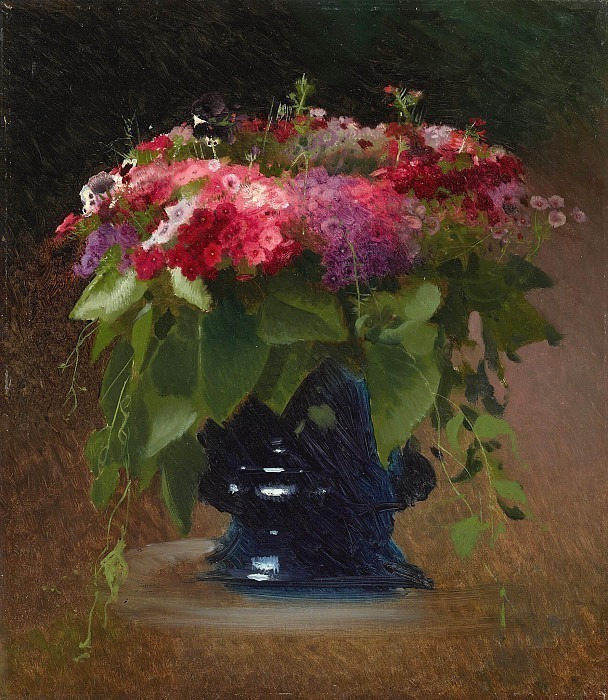Bouquet of flowers. Phlox Ivan Kramskoy (1837-1887)
Ivan Kramskoy – Bouquet of flowers. Phlox
Edit attribution
Download full size: 1777×2048 px (0,5 Mb)
Painter: Ivan Kramskoy
Location: The State Tretyakov Gallery, Moscow (Государственная Третьяковская галерея).
Kramskoi was a Russian artist who preferred genre and historical painting of all genres. He sometimes painted portraits, criticized other people’s paintings, and tried to find standards by which to accurately determine the value of works of art. He vehemently defended the idea that the artist should be not just an observer but a teacher, and that paintings should serve a greater purpose than merely reflecting reality. In his view, they should develop morality and invite one to make moral choices, they should instill taste and reflect deeply popular, national subjects, reminding people of who they were and where they came from. The paintings in his world were to be a reference point, a light in the darkness, and this very desire for light, for freedom, for goodness, is evident not only in the artist’s works but also in his life. For example, when the Academy of Arts held a major competition to celebrate the fact that the term of its existence had reached the hundred-year mark and invited students who preferred historical painting to paint on the same subject - The Feast at Valhalla - Kramskoy, along with fourteen others, left its walls and went to defend his freedom. Like any artist, however, Kramsky has not only ideologically aligned paintings designed to inspire and instruct, but also simple ones devoid of so supreme a goal.
Description of Ivan Kramskoi’s painting A Bouquet of Flowers
Kramskoi was a Russian artist who preferred genre and historical painting of all genres. He sometimes painted portraits, criticized other people’s paintings, and tried to find standards by which to accurately determine the value of works of art. He vehemently defended the idea that the artist should be not just an observer but a teacher, and that paintings should serve a greater purpose than merely reflecting reality.
In his view, they should develop morality and invite one to make moral choices, they should instill taste and reflect deeply popular, national subjects, reminding people of who they were and where they came from.
The paintings in his world were to be a reference point, a light in the darkness, and this very desire for light, for freedom, for goodness, is evident not only in the artist’s works but also in his life.
For example, when the Academy of Arts held a major competition to celebrate the fact that the term of its existence had reached the hundred-year mark and invited students who preferred historical painting to paint on the same subject - The Feast at Valhalla - Kramskoy, along with fourteen others, left its walls and went to defend his freedom.
Like any artist, however, Kramsky has not only ideologically aligned paintings designed to inspire and instruct, but also simple ones devoid of so supreme a goal. "Bouquet of Flowers" is one such painting. It depicts a bouquet of flowers in a vase, devoid of any background. Only the light that falls, vaguely outlining the outlines of the round table, serves as their support. There is no background at all - no curtains or draperies, only shimmering lights and shadows.
But the flowers themselves are very bright and saturated. It’s as if they praise life, even when cut and placed in a vase. The painting is full of bright hues - even in a simple work, Kramskoi glorifies existence, and all he needs for this is the right colors.
Кому понравилось
Пожалуйста, подождите
На эту операцию может потребоваться несколько секунд.
Информация появится в новом окне,
если открытие новых окон не запрещено в настройках вашего браузера.
You need to login
Для работы с коллекциями – пожалуйста, войдите в аккаунт (open in new window).



















You cannot comment Why?
This is a richly textured oil painting of a bouquet of flowers, predominantly phlox, arranged in a dark, ornate vase. The flowers are bursting with vibrant colors, a mix of deep reds, pinks, purples, and whites, creating a sense of abundant life and beauty. Large, lush green leaves form a backdrop and cascade down, softening the angularity of the vase. The vase itself is a deep, lustrous blue with highlights that suggest its made of polished ceramic or metal, adding a touch of opulence.
The background is a muted, dark green that fades into brown, allowing the colorful bouquet to be the absolute focal point. The surface the vase rests on has a textured, earthy brown hue, perhaps a wooden table or a woven cloth. The overall impression is one of natural beauty, abundance, and elegant domesticity.
The subtexts in this painting could be interpreted in several ways: